Accounting for Construction
VerifiedAdded on 2020/01/28
|11
|3277
|498
Report
AI Summary
This report analyzes the new requirements of IFRS 15 in comparison to IFRS 18 and IFRS 11, focusing on revenue recognition in the construction industry. It discusses the framework for recognizing revenue, the major differences between IFRS 15 and IAS 18, and the implications for entities, including necessary changes in internal processes and disclosure requirements. The report concludes that IFRS 15 enhances accounting practices in the construction sector, ensuring better revenue recognition and compliance.
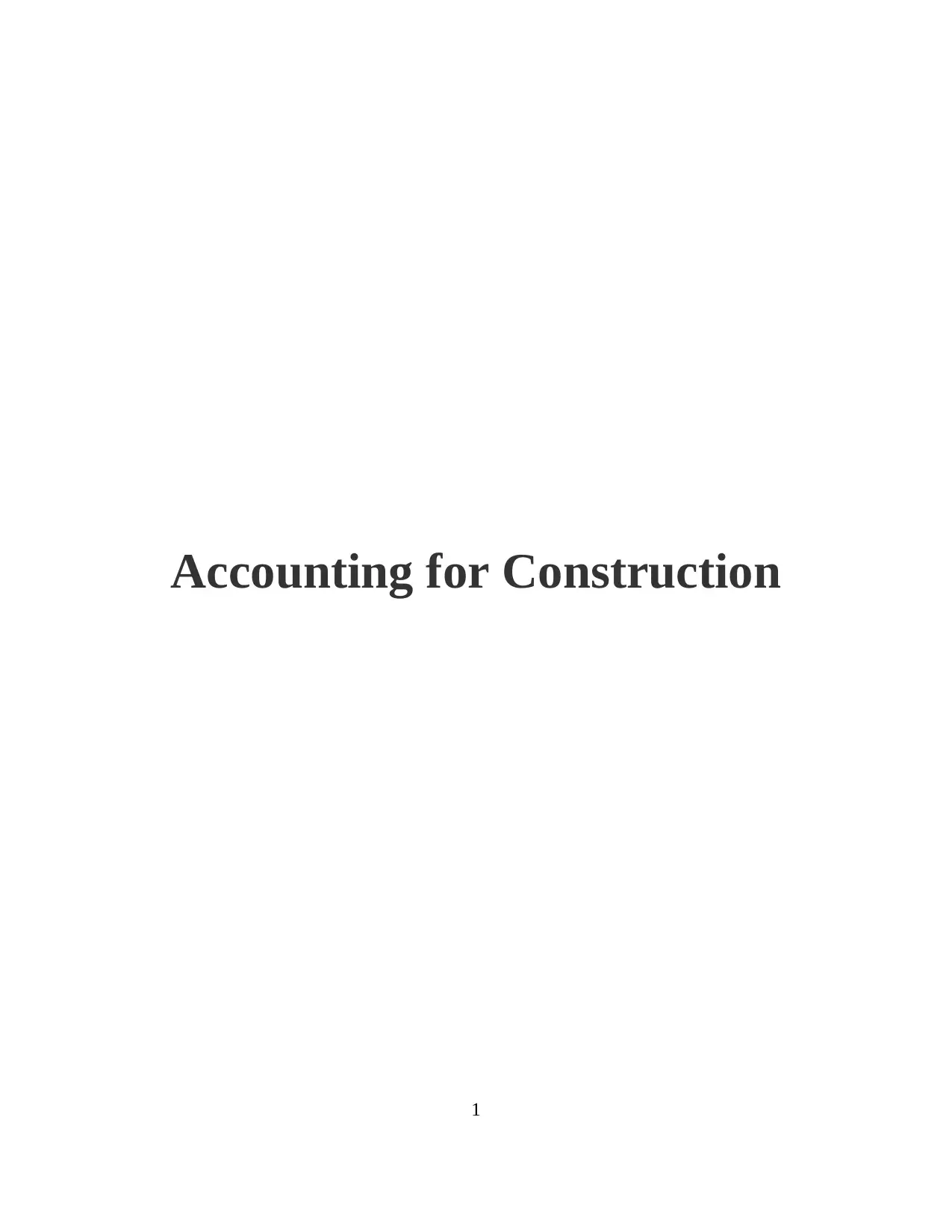
Accounting for Construction
1
1
Paraphrase This Document
Need a fresh take? Get an instant paraphrase of this document with our AI Paraphraser
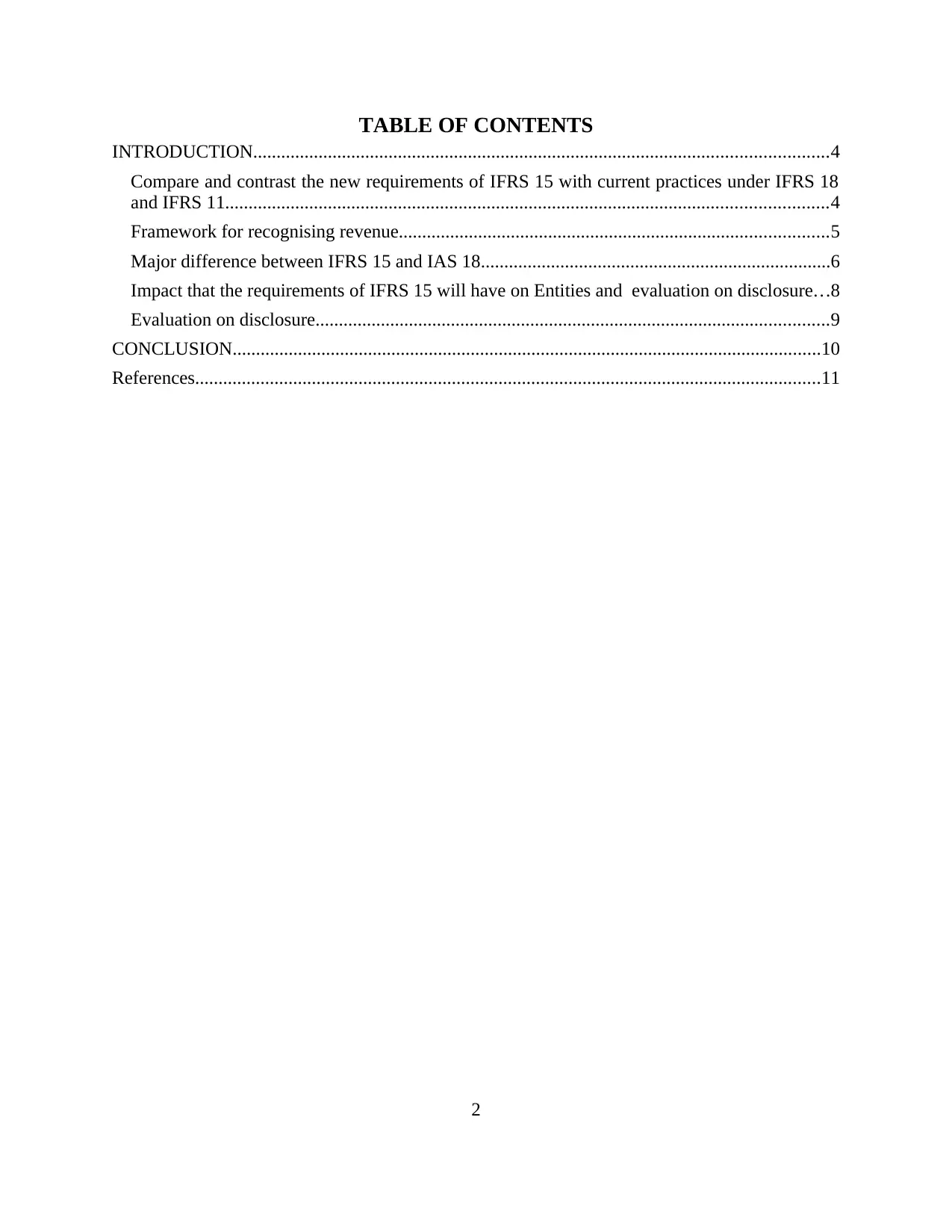
TABLE OF CONTENTS
INTRODUCTION...........................................................................................................................4
Compare and contrast the new requirements of IFRS 15 with current practices under IFRS 18
and IFRS 11.................................................................................................................................4
Framework for recognising revenue............................................................................................5
Major difference between IFRS 15 and IAS 18...........................................................................6
Impact that the requirements of IFRS 15 will have on Entities and evaluation on disclosure...8
Evaluation on disclosure..............................................................................................................9
CONCLUSION..............................................................................................................................10
References......................................................................................................................................11
2
INTRODUCTION...........................................................................................................................4
Compare and contrast the new requirements of IFRS 15 with current practices under IFRS 18
and IFRS 11.................................................................................................................................4
Framework for recognising revenue............................................................................................5
Major difference between IFRS 15 and IAS 18...........................................................................6
Impact that the requirements of IFRS 15 will have on Entities and evaluation on disclosure...8
Evaluation on disclosure..............................................................................................................9
CONCLUSION..............................................................................................................................10
References......................................................................................................................................11
2
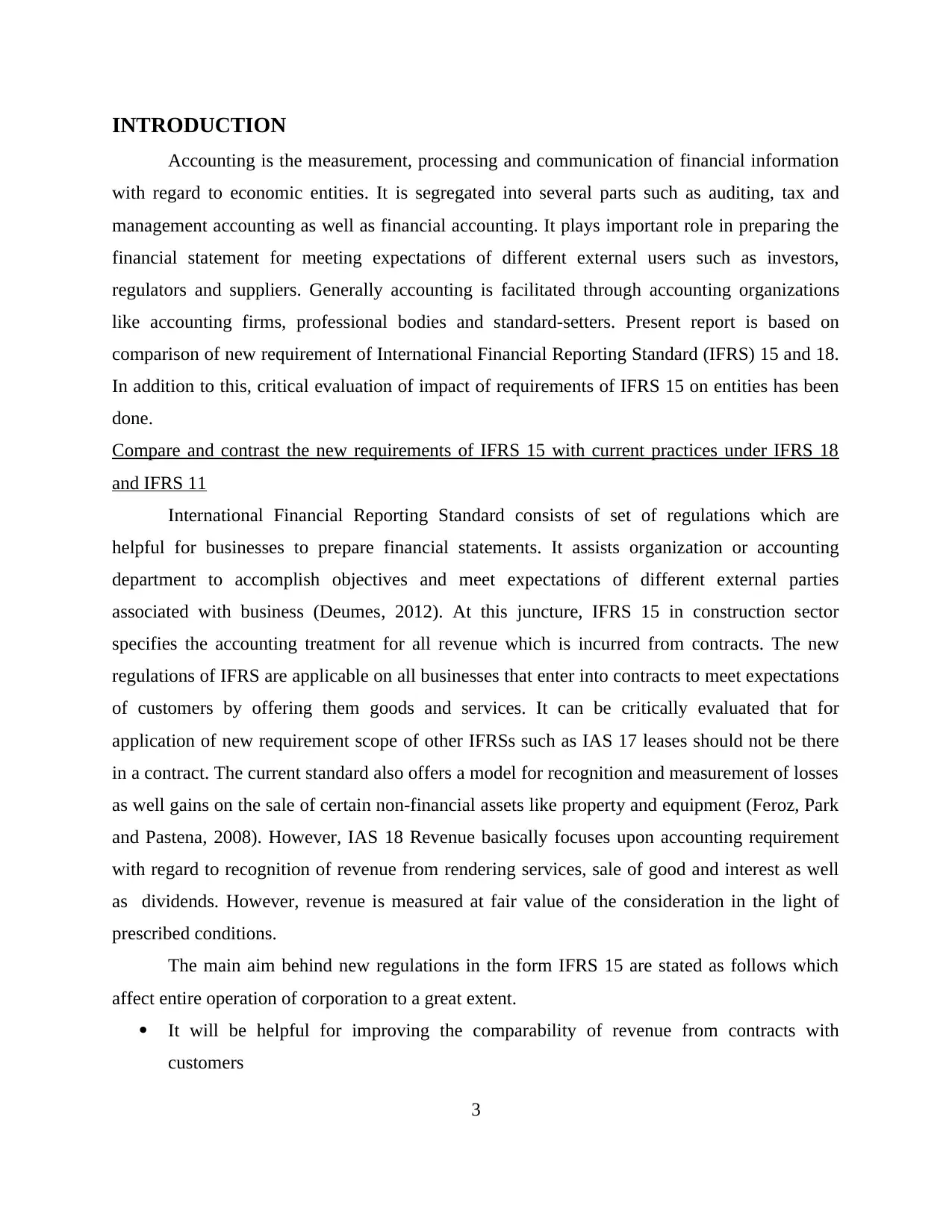
INTRODUCTION
Accounting is the measurement, processing and communication of financial information
with regard to economic entities. It is segregated into several parts such as auditing, tax and
management accounting as well as financial accounting. It plays important role in preparing the
financial statement for meeting expectations of different external users such as investors,
regulators and suppliers. Generally accounting is facilitated through accounting organizations
like accounting firms, professional bodies and standard-setters. Present report is based on
comparison of new requirement of International Financial Reporting Standard (IFRS) 15 and 18.
In addition to this, critical evaluation of impact of requirements of IFRS 15 on entities has been
done.
Compare and contrast the new requirements of IFRS 15 with current practices under IFRS 18
and IFRS 11
International Financial Reporting Standard consists of set of regulations which are
helpful for businesses to prepare financial statements. It assists organization or accounting
department to accomplish objectives and meet expectations of different external parties
associated with business (Deumes, 2012). At this juncture, IFRS 15 in construction sector
specifies the accounting treatment for all revenue which is incurred from contracts. The new
regulations of IFRS are applicable on all businesses that enter into contracts to meet expectations
of customers by offering them goods and services. It can be critically evaluated that for
application of new requirement scope of other IFRSs such as IAS 17 leases should not be there
in a contract. The current standard also offers a model for recognition and measurement of losses
as well gains on the sale of certain non-financial assets like property and equipment (Feroz, Park
and Pastena, 2008). However, IAS 18 Revenue basically focuses upon accounting requirement
with regard to recognition of revenue from rendering services, sale of good and interest as well
as dividends. However, revenue is measured at fair value of the consideration in the light of
prescribed conditions.
The main aim behind new regulations in the form IFRS 15 are stated as follows which
affect entire operation of corporation to a great extent.
It will be helpful for improving the comparability of revenue from contracts with
customers
3
Accounting is the measurement, processing and communication of financial information
with regard to economic entities. It is segregated into several parts such as auditing, tax and
management accounting as well as financial accounting. It plays important role in preparing the
financial statement for meeting expectations of different external users such as investors,
regulators and suppliers. Generally accounting is facilitated through accounting organizations
like accounting firms, professional bodies and standard-setters. Present report is based on
comparison of new requirement of International Financial Reporting Standard (IFRS) 15 and 18.
In addition to this, critical evaluation of impact of requirements of IFRS 15 on entities has been
done.
Compare and contrast the new requirements of IFRS 15 with current practices under IFRS 18
and IFRS 11
International Financial Reporting Standard consists of set of regulations which are
helpful for businesses to prepare financial statements. It assists organization or accounting
department to accomplish objectives and meet expectations of different external parties
associated with business (Deumes, 2012). At this juncture, IFRS 15 in construction sector
specifies the accounting treatment for all revenue which is incurred from contracts. The new
regulations of IFRS are applicable on all businesses that enter into contracts to meet expectations
of customers by offering them goods and services. It can be critically evaluated that for
application of new requirement scope of other IFRSs such as IAS 17 leases should not be there
in a contract. The current standard also offers a model for recognition and measurement of losses
as well gains on the sale of certain non-financial assets like property and equipment (Feroz, Park
and Pastena, 2008). However, IAS 18 Revenue basically focuses upon accounting requirement
with regard to recognition of revenue from rendering services, sale of good and interest as well
as dividends. However, revenue is measured at fair value of the consideration in the light of
prescribed conditions.
The main aim behind new regulations in the form IFRS 15 are stated as follows which
affect entire operation of corporation to a great extent.
It will be helpful for improving the comparability of revenue from contracts with
customers
3
⊘ This is a preview!⊘
Do you want full access?
Subscribe today to unlock all pages.

Trusted by 1+ million students worldwide
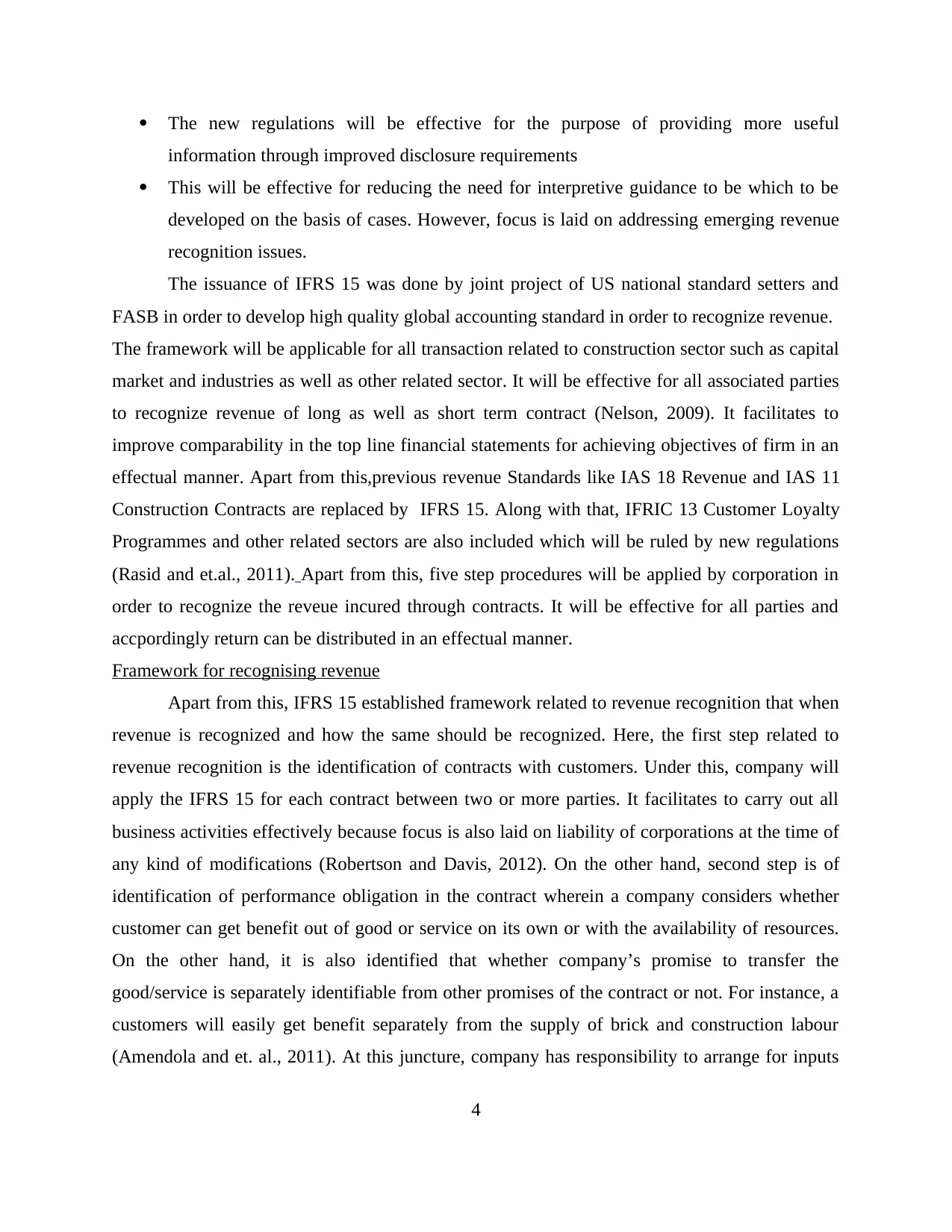
The new regulations will be effective for the purpose of providing more useful
information through improved disclosure requirements
This will be effective for reducing the need for interpretive guidance to be which to be
developed on the basis of cases. However, focus is laid on addressing emerging revenue
recognition issues.
The issuance of IFRS 15 was done by joint project of US national standard setters and
FASB in order to develop high quality global accounting standard in order to recognize revenue.
The framework will be applicable for all transaction related to construction sector such as capital
market and industries as well as other related sector. It will be effective for all associated parties
to recognize revenue of long as well as short term contract (Nelson, 2009). It facilitates to
improve comparability in the top line financial statements for achieving objectives of firm in an
effectual manner. Apart from this,previous revenue Standards like IAS 18 Revenue and IAS 11
Construction Contracts are replaced by IFRS 15. Along with that, IFRIC 13 Customer Loyalty
Programmes and other related sectors are also included which will be ruled by new regulations
(Rasid and et.al., 2011). Apart from this, five step procedures will be applied by corporation in
order to recognize the reveue incured through contracts. It will be effective for all parties and
accpordingly return can be distributed in an effectual manner.
Framework for recognising revenue
Apart from this, IFRS 15 established framework related to revenue recognition that when
revenue is recognized and how the same should be recognized. Here, the first step related to
revenue recognition is the identification of contracts with customers. Under this, company will
apply the IFRS 15 for each contract between two or more parties. It facilitates to carry out all
business activities effectively because focus is also laid on liability of corporations at the time of
any kind of modifications (Robertson and Davis, 2012). On the other hand, second step is of
identification of performance obligation in the contract wherein a company considers whether
customer can get benefit out of good or service on its own or with the availability of resources.
On the other hand, it is also identified that whether company’s promise to transfer the
good/service is separately identifiable from other promises of the contract or not. For instance, a
customers will easily get benefit separately from the supply of brick and construction labour
(Amendola and et. al., 2011). At this juncture, company has responsibility to arrange for inputs
4
information through improved disclosure requirements
This will be effective for reducing the need for interpretive guidance to be which to be
developed on the basis of cases. However, focus is laid on addressing emerging revenue
recognition issues.
The issuance of IFRS 15 was done by joint project of US national standard setters and
FASB in order to develop high quality global accounting standard in order to recognize revenue.
The framework will be applicable for all transaction related to construction sector such as capital
market and industries as well as other related sector. It will be effective for all associated parties
to recognize revenue of long as well as short term contract (Nelson, 2009). It facilitates to
improve comparability in the top line financial statements for achieving objectives of firm in an
effectual manner. Apart from this,previous revenue Standards like IAS 18 Revenue and IAS 11
Construction Contracts are replaced by IFRS 15. Along with that, IFRIC 13 Customer Loyalty
Programmes and other related sectors are also included which will be ruled by new regulations
(Rasid and et.al., 2011). Apart from this, five step procedures will be applied by corporation in
order to recognize the reveue incured through contracts. It will be effective for all parties and
accpordingly return can be distributed in an effectual manner.
Framework for recognising revenue
Apart from this, IFRS 15 established framework related to revenue recognition that when
revenue is recognized and how the same should be recognized. Here, the first step related to
revenue recognition is the identification of contracts with customers. Under this, company will
apply the IFRS 15 for each contract between two or more parties. It facilitates to carry out all
business activities effectively because focus is also laid on liability of corporations at the time of
any kind of modifications (Robertson and Davis, 2012). On the other hand, second step is of
identification of performance obligation in the contract wherein a company considers whether
customer can get benefit out of good or service on its own or with the availability of resources.
On the other hand, it is also identified that whether company’s promise to transfer the
good/service is separately identifiable from other promises of the contract or not. For instance, a
customers will easily get benefit separately from the supply of brick and construction labour
(Amendola and et. al., 2011). At this juncture, company has responsibility to arrange for inputs
4
Paraphrase This Document
Need a fresh take? Get an instant paraphrase of this document with our AI Paraphraser
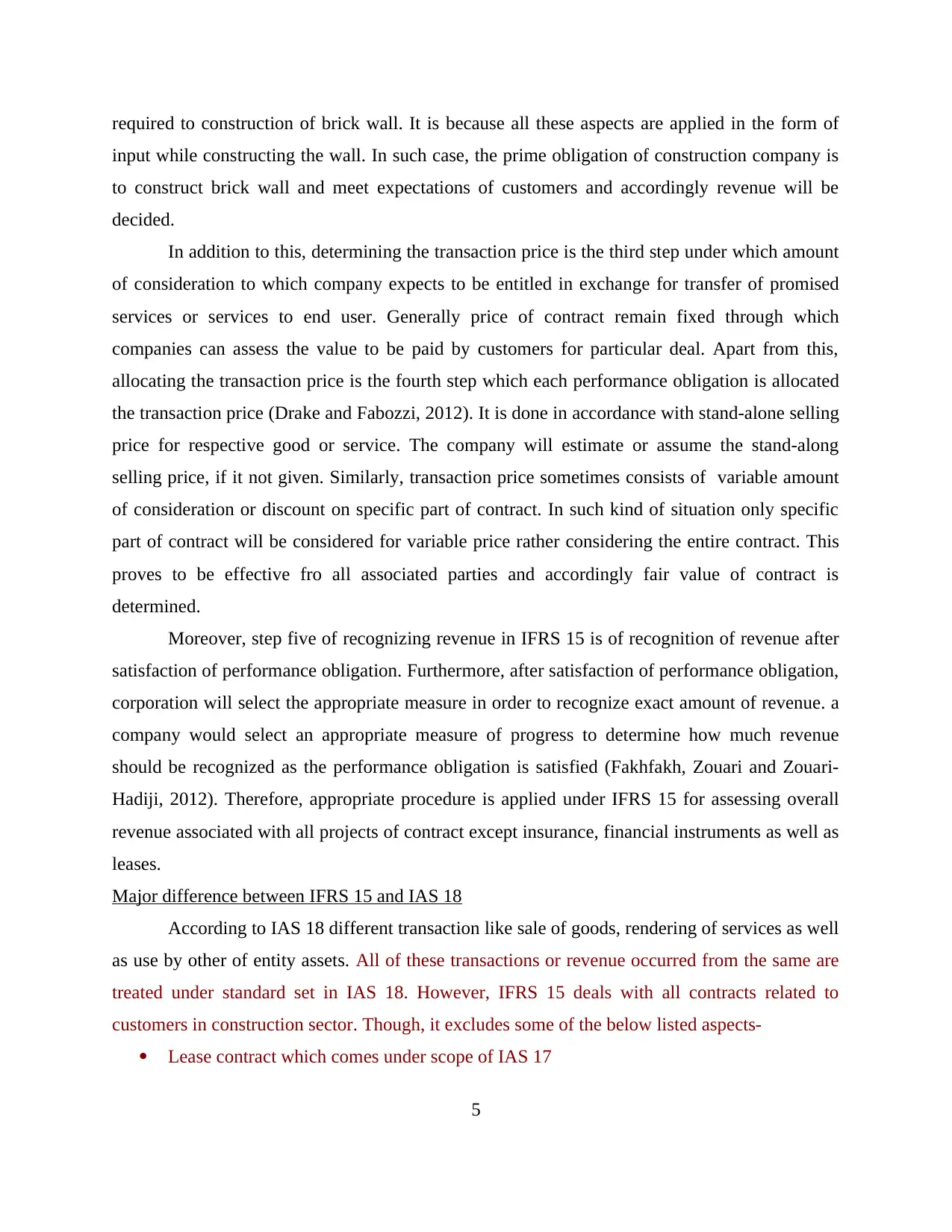
required to construction of brick wall. It is because all these aspects are applied in the form of
input while constructing the wall. In such case, the prime obligation of construction company is
to construct brick wall and meet expectations of customers and accordingly revenue will be
decided.
In addition to this, determining the transaction price is the third step under which amount
of consideration to which company expects to be entitled in exchange for transfer of promised
services or services to end user. Generally price of contract remain fixed through which
companies can assess the value to be paid by customers for particular deal. Apart from this,
allocating the transaction price is the fourth step which each performance obligation is allocated
the transaction price (Drake and Fabozzi, 2012). It is done in accordance with stand-alone selling
price for respective good or service. The company will estimate or assume the stand-along
selling price, if it not given. Similarly, transaction price sometimes consists of variable amount
of consideration or discount on specific part of contract. In such kind of situation only specific
part of contract will be considered for variable price rather considering the entire contract. This
proves to be effective fro all associated parties and accordingly fair value of contract is
determined.
Moreover, step five of recognizing revenue in IFRS 15 is of recognition of revenue after
satisfaction of performance obligation. Furthermore, after satisfaction of performance obligation,
corporation will select the appropriate measure in order to recognize exact amount of revenue. a
company would select an appropriate measure of progress to determine how much revenue
should be recognized as the performance obligation is satisfied (Fakhfakh, Zouari and Zouari-
Hadiji, 2012). Therefore, appropriate procedure is applied under IFRS 15 for assessing overall
revenue associated with all projects of contract except insurance, financial instruments as well as
leases.
Major difference between IFRS 15 and IAS 18
According to IAS 18 different transaction like sale of goods, rendering of services as well
as use by other of entity assets. All of these transactions or revenue occurred from the same are
treated under standard set in IAS 18. However, IFRS 15 deals with all contracts related to
customers in construction sector. Though, it excludes some of the below listed aspects-
Lease contract which comes under scope of IAS 17
5
input while constructing the wall. In such case, the prime obligation of construction company is
to construct brick wall and meet expectations of customers and accordingly revenue will be
decided.
In addition to this, determining the transaction price is the third step under which amount
of consideration to which company expects to be entitled in exchange for transfer of promised
services or services to end user. Generally price of contract remain fixed through which
companies can assess the value to be paid by customers for particular deal. Apart from this,
allocating the transaction price is the fourth step which each performance obligation is allocated
the transaction price (Drake and Fabozzi, 2012). It is done in accordance with stand-alone selling
price for respective good or service. The company will estimate or assume the stand-along
selling price, if it not given. Similarly, transaction price sometimes consists of variable amount
of consideration or discount on specific part of contract. In such kind of situation only specific
part of contract will be considered for variable price rather considering the entire contract. This
proves to be effective fro all associated parties and accordingly fair value of contract is
determined.
Moreover, step five of recognizing revenue in IFRS 15 is of recognition of revenue after
satisfaction of performance obligation. Furthermore, after satisfaction of performance obligation,
corporation will select the appropriate measure in order to recognize exact amount of revenue. a
company would select an appropriate measure of progress to determine how much revenue
should be recognized as the performance obligation is satisfied (Fakhfakh, Zouari and Zouari-
Hadiji, 2012). Therefore, appropriate procedure is applied under IFRS 15 for assessing overall
revenue associated with all projects of contract except insurance, financial instruments as well as
leases.
Major difference between IFRS 15 and IAS 18
According to IAS 18 different transaction like sale of goods, rendering of services as well
as use by other of entity assets. All of these transactions or revenue occurred from the same are
treated under standard set in IAS 18. However, IFRS 15 deals with all contracts related to
customers in construction sector. Though, it excludes some of the below listed aspects-
Lease contract which comes under scope of IAS 17
5
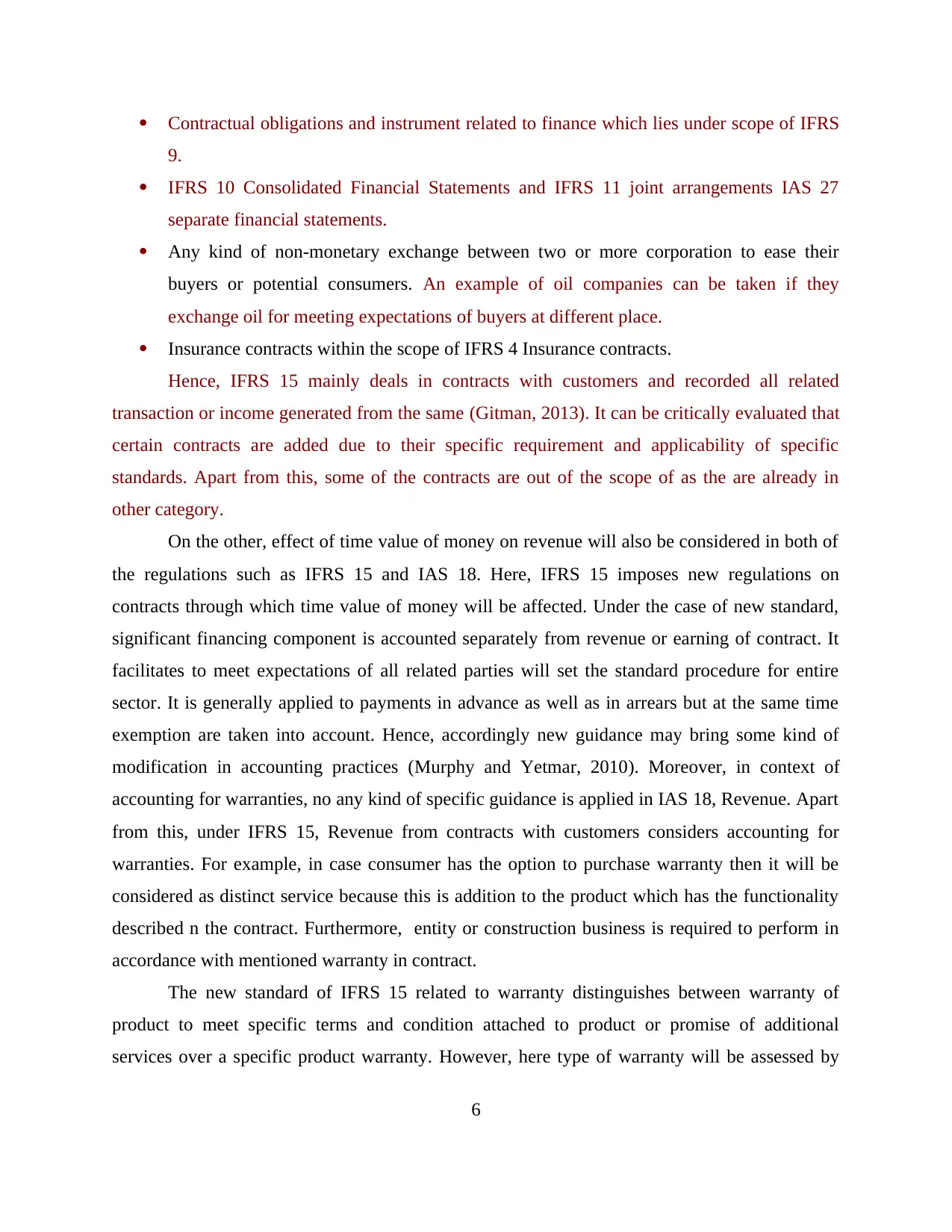
Contractual obligations and instrument related to finance which lies under scope of IFRS
9.
IFRS 10 Consolidated Financial Statements and IFRS 11 joint arrangements IAS 27
separate financial statements.
Any kind of non-monetary exchange between two or more corporation to ease their
buyers or potential consumers. An example of oil companies can be taken if they
exchange oil for meeting expectations of buyers at different place.
Insurance contracts within the scope of IFRS 4 Insurance contracts.
Hence, IFRS 15 mainly deals in contracts with customers and recorded all related
transaction or income generated from the same (Gitman, 2013). It can be critically evaluated that
certain contracts are added due to their specific requirement and applicability of specific
standards. Apart from this, some of the contracts are out of the scope of as the are already in
other category.
On the other, effect of time value of money on revenue will also be considered in both of
the regulations such as IFRS 15 and IAS 18. Here, IFRS 15 imposes new regulations on
contracts through which time value of money will be affected. Under the case of new standard,
significant financing component is accounted separately from revenue or earning of contract. It
facilitates to meet expectations of all related parties will set the standard procedure for entire
sector. It is generally applied to payments in advance as well as in arrears but at the same time
exemption are taken into account. Hence, accordingly new guidance may bring some kind of
modification in accounting practices (Murphy and Yetmar, 2010). Moreover, in context of
accounting for warranties, no any kind of specific guidance is applied in IAS 18, Revenue. Apart
from this, under IFRS 15, Revenue from contracts with customers considers accounting for
warranties. For example, in case consumer has the option to purchase warranty then it will be
considered as distinct service because this is addition to the product which has the functionality
described n the contract. Furthermore, entity or construction business is required to perform in
accordance with mentioned warranty in contract.
The new standard of IFRS 15 related to warranty distinguishes between warranty of
product to meet specific terms and condition attached to product or promise of additional
services over a specific product warranty. However, here type of warranty will be assessed by
6
9.
IFRS 10 Consolidated Financial Statements and IFRS 11 joint arrangements IAS 27
separate financial statements.
Any kind of non-monetary exchange between two or more corporation to ease their
buyers or potential consumers. An example of oil companies can be taken if they
exchange oil for meeting expectations of buyers at different place.
Insurance contracts within the scope of IFRS 4 Insurance contracts.
Hence, IFRS 15 mainly deals in contracts with customers and recorded all related
transaction or income generated from the same (Gitman, 2013). It can be critically evaluated that
certain contracts are added due to their specific requirement and applicability of specific
standards. Apart from this, some of the contracts are out of the scope of as the are already in
other category.
On the other, effect of time value of money on revenue will also be considered in both of
the regulations such as IFRS 15 and IAS 18. Here, IFRS 15 imposes new regulations on
contracts through which time value of money will be affected. Under the case of new standard,
significant financing component is accounted separately from revenue or earning of contract. It
facilitates to meet expectations of all related parties will set the standard procedure for entire
sector. It is generally applied to payments in advance as well as in arrears but at the same time
exemption are taken into account. Hence, accordingly new guidance may bring some kind of
modification in accounting practices (Murphy and Yetmar, 2010). Moreover, in context of
accounting for warranties, no any kind of specific guidance is applied in IAS 18, Revenue. Apart
from this, under IFRS 15, Revenue from contracts with customers considers accounting for
warranties. For example, in case consumer has the option to purchase warranty then it will be
considered as distinct service because this is addition to the product which has the functionality
described n the contract. Furthermore, entity or construction business is required to perform in
accordance with mentioned warranty in contract.
The new standard of IFRS 15 related to warranty distinguishes between warranty of
product to meet specific terms and condition attached to product or promise of additional
services over a specific product warranty. However, here type of warranty will be assessed by
6
⊘ This is a preview!⊘
Do you want full access?
Subscribe today to unlock all pages.

Trusted by 1+ million students worldwide
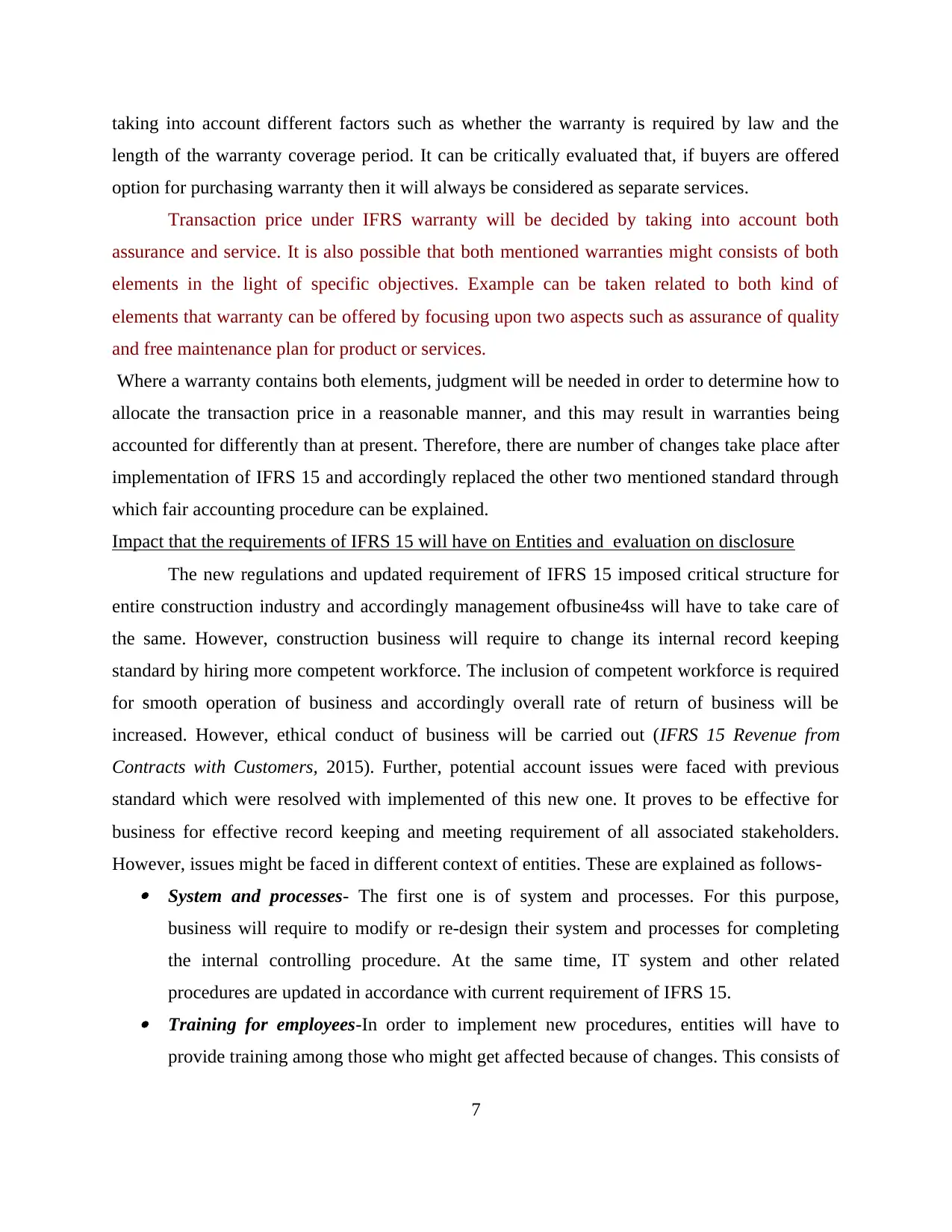
taking into account different factors such as whether the warranty is required by law and the
length of the warranty coverage period. It can be critically evaluated that, if buyers are offered
option for purchasing warranty then it will always be considered as separate services.
Transaction price under IFRS warranty will be decided by taking into account both
assurance and service. It is also possible that both mentioned warranties might consists of both
elements in the light of specific objectives. Example can be taken related to both kind of
elements that warranty can be offered by focusing upon two aspects such as assurance of quality
and free maintenance plan for product or services.
Where a warranty contains both elements, judgment will be needed in order to determine how to
allocate the transaction price in a reasonable manner, and this may result in warranties being
accounted for differently than at present. Therefore, there are number of changes take place after
implementation of IFRS 15 and accordingly replaced the other two mentioned standard through
which fair accounting procedure can be explained.
Impact that the requirements of IFRS 15 will have on Entities and evaluation on disclosure
The new regulations and updated requirement of IFRS 15 imposed critical structure for
entire construction industry and accordingly management ofbusine4ss will have to take care of
the same. However, construction business will require to change its internal record keeping
standard by hiring more competent workforce. The inclusion of competent workforce is required
for smooth operation of business and accordingly overall rate of return of business will be
increased. However, ethical conduct of business will be carried out (IFRS 15 Revenue from
Contracts with Customers, 2015). Further, potential account issues were faced with previous
standard which were resolved with implemented of this new one. It proves to be effective for
business for effective record keeping and meeting requirement of all associated stakeholders.
However, issues might be faced in different context of entities. These are explained as follows- System and processes- The first one is of system and processes. For this purpose,
business will require to modify or re-design their system and processes for completing
the internal controlling procedure. At the same time, IT system and other related
procedures are updated in accordance with current requirement of IFRS 15. Training for employees-In order to implement new procedures, entities will have to
provide training among those who might get affected because of changes. This consists of
7
length of the warranty coverage period. It can be critically evaluated that, if buyers are offered
option for purchasing warranty then it will always be considered as separate services.
Transaction price under IFRS warranty will be decided by taking into account both
assurance and service. It is also possible that both mentioned warranties might consists of both
elements in the light of specific objectives. Example can be taken related to both kind of
elements that warranty can be offered by focusing upon two aspects such as assurance of quality
and free maintenance plan for product or services.
Where a warranty contains both elements, judgment will be needed in order to determine how to
allocate the transaction price in a reasonable manner, and this may result in warranties being
accounted for differently than at present. Therefore, there are number of changes take place after
implementation of IFRS 15 and accordingly replaced the other two mentioned standard through
which fair accounting procedure can be explained.
Impact that the requirements of IFRS 15 will have on Entities and evaluation on disclosure
The new regulations and updated requirement of IFRS 15 imposed critical structure for
entire construction industry and accordingly management ofbusine4ss will have to take care of
the same. However, construction business will require to change its internal record keeping
standard by hiring more competent workforce. The inclusion of competent workforce is required
for smooth operation of business and accordingly overall rate of return of business will be
increased. However, ethical conduct of business will be carried out (IFRS 15 Revenue from
Contracts with Customers, 2015). Further, potential account issues were faced with previous
standard which were resolved with implemented of this new one. It proves to be effective for
business for effective record keeping and meeting requirement of all associated stakeholders.
However, issues might be faced in different context of entities. These are explained as follows- System and processes- The first one is of system and processes. For this purpose,
business will require to modify or re-design their system and processes for completing
the internal controlling procedure. At the same time, IT system and other related
procedures are updated in accordance with current requirement of IFRS 15. Training for employees-In order to implement new procedures, entities will have to
provide training among those who might get affected because of changes. This consists of
7
Paraphrase This Document
Need a fresh take? Get an instant paraphrase of this document with our AI Paraphraser
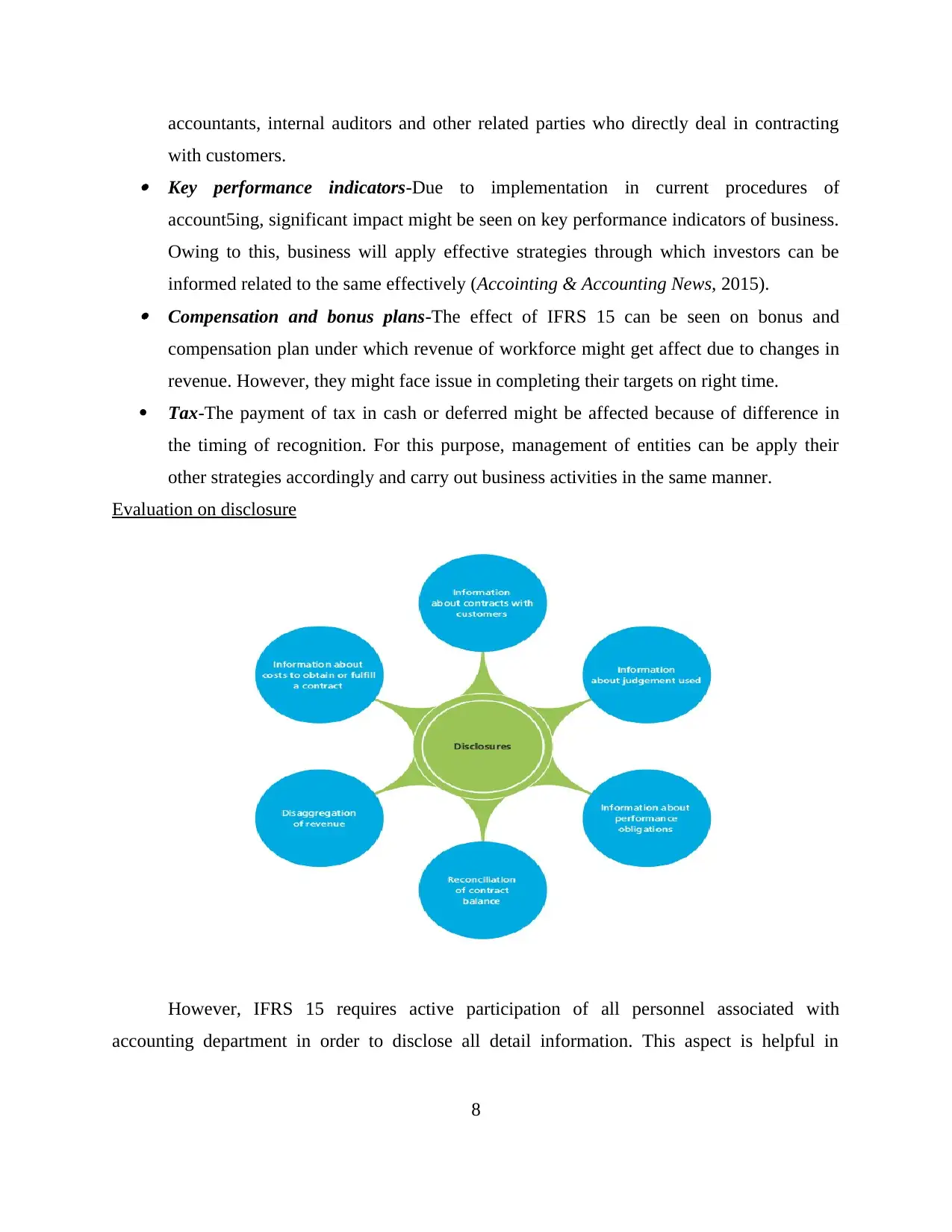
accountants, internal auditors and other related parties who directly deal in contracting
with customers. Key performance indicators-Due to implementation in current procedures of
account5ing, significant impact might be seen on key performance indicators of business.
Owing to this, business will apply effective strategies through which investors can be
informed related to the same effectively (Accointing & Accounting News, 2015). Compensation and bonus plans-The effect of IFRS 15 can be seen on bonus and
compensation plan under which revenue of workforce might get affect due to changes in
revenue. However, they might face issue in completing their targets on right time.
Tax-The payment of tax in cash or deferred might be affected because of difference in
the timing of recognition. For this purpose, management of entities can be apply their
other strategies accordingly and carry out business activities in the same manner.
Evaluation on disclosure
However, IFRS 15 requires active participation of all personnel associated with
accounting department in order to disclose all detail information. This aspect is helpful in
8
with customers. Key performance indicators-Due to implementation in current procedures of
account5ing, significant impact might be seen on key performance indicators of business.
Owing to this, business will apply effective strategies through which investors can be
informed related to the same effectively (Accointing & Accounting News, 2015). Compensation and bonus plans-The effect of IFRS 15 can be seen on bonus and
compensation plan under which revenue of workforce might get affect due to changes in
revenue. However, they might face issue in completing their targets on right time.
Tax-The payment of tax in cash or deferred might be affected because of difference in
the timing of recognition. For this purpose, management of entities can be apply their
other strategies accordingly and carry out business activities in the same manner.
Evaluation on disclosure
However, IFRS 15 requires active participation of all personnel associated with
accounting department in order to disclose all detail information. This aspect is helpful in
8
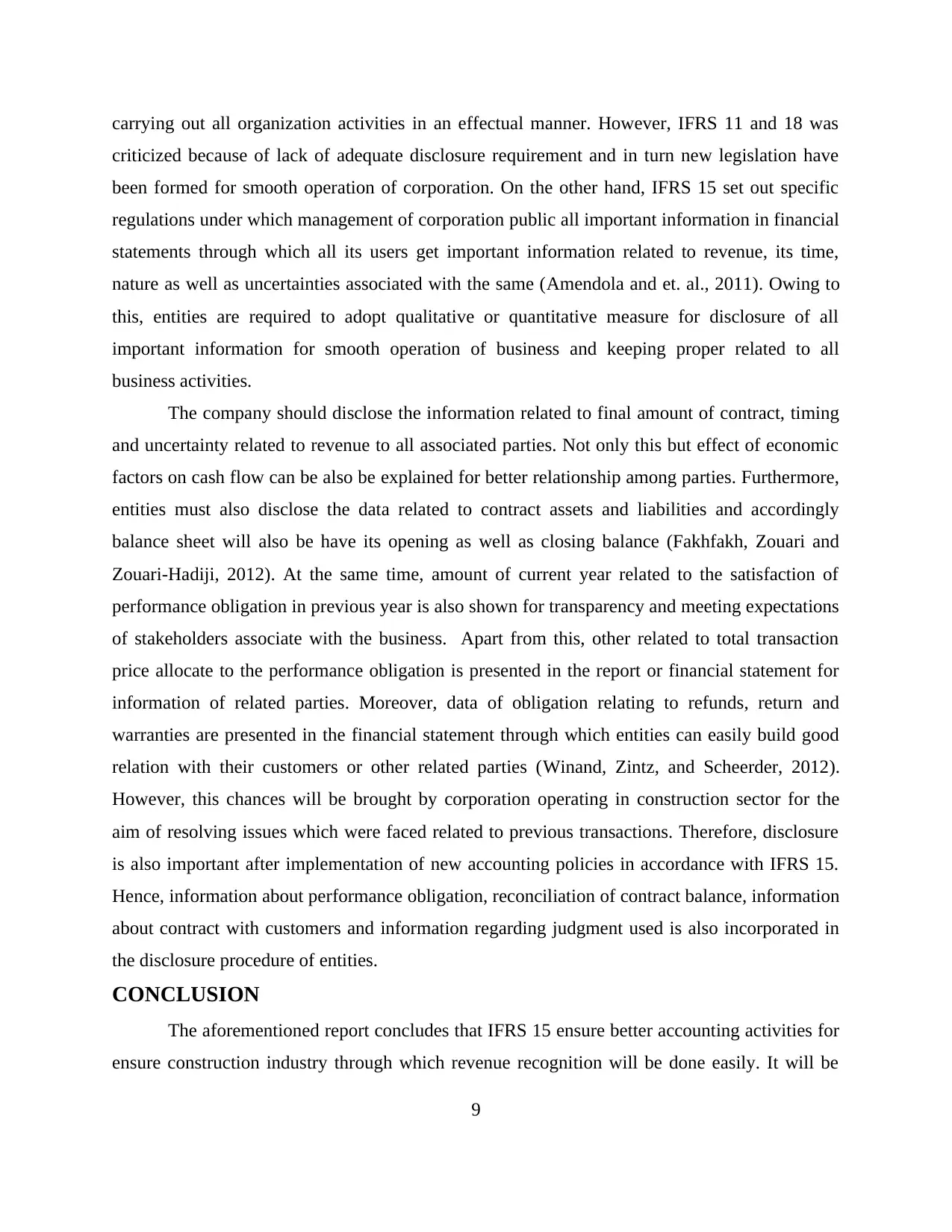
carrying out all organization activities in an effectual manner. However, IFRS 11 and 18 was
criticized because of lack of adequate disclosure requirement and in turn new legislation have
been formed for smooth operation of corporation. On the other hand, IFRS 15 set out specific
regulations under which management of corporation public all important information in financial
statements through which all its users get important information related to revenue, its time,
nature as well as uncertainties associated with the same (Amendola and et. al., 2011). Owing to
this, entities are required to adopt qualitative or quantitative measure for disclosure of all
important information for smooth operation of business and keeping proper related to all
business activities.
The company should disclose the information related to final amount of contract, timing
and uncertainty related to revenue to all associated parties. Not only this but effect of economic
factors on cash flow can be also be explained for better relationship among parties. Furthermore,
entities must also disclose the data related to contract assets and liabilities and accordingly
balance sheet will also be have its opening as well as closing balance (Fakhfakh, Zouari and
Zouari-Hadiji, 2012). At the same time, amount of current year related to the satisfaction of
performance obligation in previous year is also shown for transparency and meeting expectations
of stakeholders associate with the business. Apart from this, other related to total transaction
price allocate to the performance obligation is presented in the report or financial statement for
information of related parties. Moreover, data of obligation relating to refunds, return and
warranties are presented in the financial statement through which entities can easily build good
relation with their customers or other related parties (Winand, Zintz, and Scheerder, 2012).
However, this chances will be brought by corporation operating in construction sector for the
aim of resolving issues which were faced related to previous transactions. Therefore, disclosure
is also important after implementation of new accounting policies in accordance with IFRS 15.
Hence, information about performance obligation, reconciliation of contract balance, information
about contract with customers and information regarding judgment used is also incorporated in
the disclosure procedure of entities.
CONCLUSION
The aforementioned report concludes that IFRS 15 ensure better accounting activities for
ensure construction industry through which revenue recognition will be done easily. It will be
9
criticized because of lack of adequate disclosure requirement and in turn new legislation have
been formed for smooth operation of corporation. On the other hand, IFRS 15 set out specific
regulations under which management of corporation public all important information in financial
statements through which all its users get important information related to revenue, its time,
nature as well as uncertainties associated with the same (Amendola and et. al., 2011). Owing to
this, entities are required to adopt qualitative or quantitative measure for disclosure of all
important information for smooth operation of business and keeping proper related to all
business activities.
The company should disclose the information related to final amount of contract, timing
and uncertainty related to revenue to all associated parties. Not only this but effect of economic
factors on cash flow can be also be explained for better relationship among parties. Furthermore,
entities must also disclose the data related to contract assets and liabilities and accordingly
balance sheet will also be have its opening as well as closing balance (Fakhfakh, Zouari and
Zouari-Hadiji, 2012). At the same time, amount of current year related to the satisfaction of
performance obligation in previous year is also shown for transparency and meeting expectations
of stakeholders associate with the business. Apart from this, other related to total transaction
price allocate to the performance obligation is presented in the report or financial statement for
information of related parties. Moreover, data of obligation relating to refunds, return and
warranties are presented in the financial statement through which entities can easily build good
relation with their customers or other related parties (Winand, Zintz, and Scheerder, 2012).
However, this chances will be brought by corporation operating in construction sector for the
aim of resolving issues which were faced related to previous transactions. Therefore, disclosure
is also important after implementation of new accounting policies in accordance with IFRS 15.
Hence, information about performance obligation, reconciliation of contract balance, information
about contract with customers and information regarding judgment used is also incorporated in
the disclosure procedure of entities.
CONCLUSION
The aforementioned report concludes that IFRS 15 ensure better accounting activities for
ensure construction industry through which revenue recognition will be done easily. It will be
9
⊘ This is a preview!⊘
Do you want full access?
Subscribe today to unlock all pages.

Trusted by 1+ million students worldwide

effective fro all related parties of business because uncertainty, timing and nature of revenue all
will be recognized on prior basis. It can also be said that businesses will face issues in
implemented the new accounting policies and accordingly necessary changes will be done on
their internal record keeping procedure.
10
will be recognized on prior basis. It can also be said that businesses will face issues in
implemented the new accounting policies and accordingly necessary changes will be done on
their internal record keeping procedure.
10
Paraphrase This Document
Need a fresh take? Get an instant paraphrase of this document with our AI Paraphraser
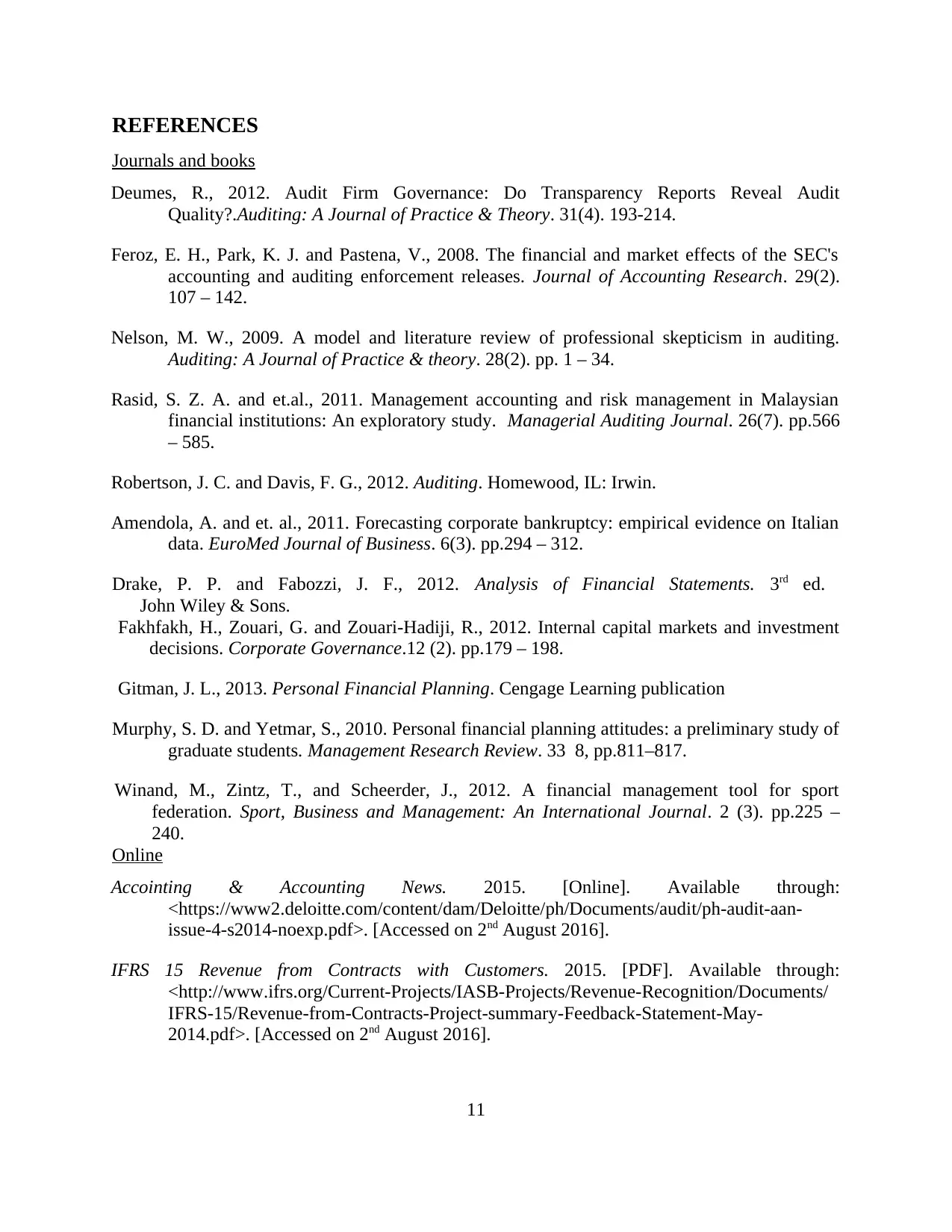
REFERENCES
Journals and books
Deumes, R., 2012. Audit Firm Governance: Do Transparency Reports Reveal Audit
Quality?.Auditing: A Journal of Practice & Theory. 31(4). 193-214.
Feroz, E. H., Park, K. J. and Pastena, V., 2008. The financial and market effects of the SEC's
accounting and auditing enforcement releases. Journal of Accounting Research. 29(2).
107 – 142.
Nelson, M. W., 2009. A model and literature review of professional skepticism in auditing.
Auditing: A Journal of Practice & theory. 28(2). pp. 1 – 34.
Rasid, S. Z. A. and et.al., 2011. Management accounting and risk management in Malaysian
financial institutions: An exploratory study. Managerial Auditing Journal. 26(7). pp.566
– 585.
Robertson, J. C. and Davis, F. G., 2012. Auditing. Homewood, IL: Irwin.
Amendola, A. and et. al., 2011. Forecasting corporate bankruptcy: empirical evidence on Italian
data. EuroMed Journal of Business. 6(3). pp.294 – 312.
Drake, P. P. and Fabozzi, J. F., 2012. Analysis of Financial Statements. 3rd ed.
John Wiley & Sons.
Fakhfakh, H., Zouari, G. and Zouari-Hadiji, R., 2012. Internal capital markets and investment
decisions. Corporate Governance.12 (2). pp.179 – 198.
Gitman, J. L., 2013. Personal Financial Planning. Cengage Learning publication
Murphy, S. D. and Yetmar, S., 2010. Personal financial planning attitudes: a preliminary study of
graduate students. Management Research Review. 33 8, pp.811–817.
Winand, M., Zintz, T., and Scheerder, J., 2012. A financial management tool for sport
federation. Sport, Business and Management: An International Journal. 2 (3). pp.225 –
240.
Online
Accointing & Accounting News. 2015. [Online]. Available through:
<https://www2.deloitte.com/content/dam/Deloitte/ph/Documents/audit/ph-audit-aan-
issue-4-s2014-noexp.pdf>. [Accessed on 2nd August 2016].
IFRS 15 Revenue from Contracts with Customers. 2015. [PDF]. Available through:
<http://www.ifrs.org/Current-Projects/IASB-Projects/Revenue-Recognition/Documents/
IFRS-15/Revenue-from-Contracts-Project-summary-Feedback-Statement-May-
2014.pdf>. [Accessed on 2nd August 2016].
11
Journals and books
Deumes, R., 2012. Audit Firm Governance: Do Transparency Reports Reveal Audit
Quality?.Auditing: A Journal of Practice & Theory. 31(4). 193-214.
Feroz, E. H., Park, K. J. and Pastena, V., 2008. The financial and market effects of the SEC's
accounting and auditing enforcement releases. Journal of Accounting Research. 29(2).
107 – 142.
Nelson, M. W., 2009. A model and literature review of professional skepticism in auditing.
Auditing: A Journal of Practice & theory. 28(2). pp. 1 – 34.
Rasid, S. Z. A. and et.al., 2011. Management accounting and risk management in Malaysian
financial institutions: An exploratory study. Managerial Auditing Journal. 26(7). pp.566
– 585.
Robertson, J. C. and Davis, F. G., 2012. Auditing. Homewood, IL: Irwin.
Amendola, A. and et. al., 2011. Forecasting corporate bankruptcy: empirical evidence on Italian
data. EuroMed Journal of Business. 6(3). pp.294 – 312.
Drake, P. P. and Fabozzi, J. F., 2012. Analysis of Financial Statements. 3rd ed.
John Wiley & Sons.
Fakhfakh, H., Zouari, G. and Zouari-Hadiji, R., 2012. Internal capital markets and investment
decisions. Corporate Governance.12 (2). pp.179 – 198.
Gitman, J. L., 2013. Personal Financial Planning. Cengage Learning publication
Murphy, S. D. and Yetmar, S., 2010. Personal financial planning attitudes: a preliminary study of
graduate students. Management Research Review. 33 8, pp.811–817.
Winand, M., Zintz, T., and Scheerder, J., 2012. A financial management tool for sport
federation. Sport, Business and Management: An International Journal. 2 (3). pp.225 –
240.
Online
Accointing & Accounting News. 2015. [Online]. Available through:
<https://www2.deloitte.com/content/dam/Deloitte/ph/Documents/audit/ph-audit-aan-
issue-4-s2014-noexp.pdf>. [Accessed on 2nd August 2016].
IFRS 15 Revenue from Contracts with Customers. 2015. [PDF]. Available through:
<http://www.ifrs.org/Current-Projects/IASB-Projects/Revenue-Recognition/Documents/
IFRS-15/Revenue-from-Contracts-Project-summary-Feedback-Statement-May-
2014.pdf>. [Accessed on 2nd August 2016].
11
1 out of 11
Related Documents
Your All-in-One AI-Powered Toolkit for Academic Success.
+13062052269
info@desklib.com
Available 24*7 on WhatsApp / Email
![[object Object]](/_next/static/media/star-bottom.7253800d.svg)
Unlock your academic potential
Copyright © 2020–2025 A2Z Services. All Rights Reserved. Developed and managed by ZUCOL.




